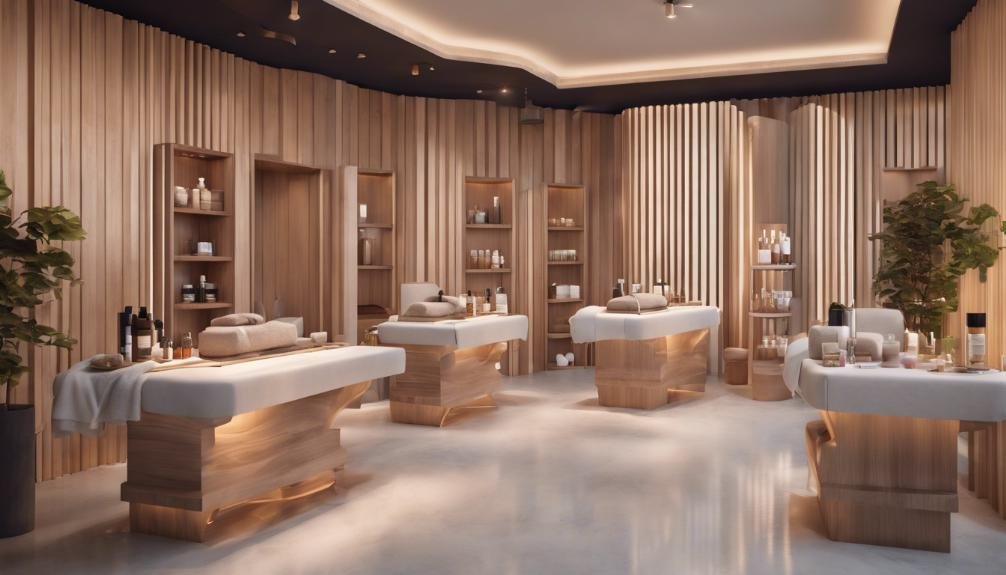How to Open a Beauty Salon or Spa
To open a successful beauty salon or spa, start with thorough market research to understand your competition, target market, and upcoming trends. Develop a detailed business plan including financial projections, marketing strategies, and staffing needs. Select a location with good traffic flow and diversity. Obtain necessary licenses and permits. Focus on interior design to create a welcoming ambiance. Establish a strong brand identity through effective marketing. Hire and train staff aligned with your salon's vision. These steps lay a solid foundation for your beauty business.
Key Takeaways
- Conduct thorough market research to understand competitors, target market, and trends.
- Develop a comprehensive business plan with financial projections and competitive analysis.
- Choose a strategic location based on accessibility, competition, and potential clientele.
- Obtain necessary licenses and permits to establish credibility and trust.
- Focus on branding, marketing strategies, and staff training to create a successful salon or spa.
Market Research
Why is thorough market research essential before opening a beauty salon or spa?
Before diving into the beauty industry, understanding your competitors, target market, and industry trends is imperative. Conducting a competitor analysis provides valuable insights into what similar businesses are offering, their pricing strategies, and unique selling points. This information helps you position your salon or spa effectively in the market.
Identifying your target market is equally significant. By understanding the demographics, preferences, and needs of your potential customers, you can tailor your services to meet their expectations.
Trend forecasting allows you to stay ahead of the curve by predicting upcoming beauty trends, ensuring your salon remains relevant and appealing to customers.
Customer feedback is another crucial aspect of market research. By listening to your target market's opinions and suggestions, you can continuously improve your services and customer experience. Incorporating feedback helps build customer loyalty and enhances your salon's reputation in the competitive beauty industry.
Business Plan
Conducting thorough market research sets the foundation for a successful beauty salon or spa; now, it's time to craft a detailed business plan that outlines your strategies, goals, and operational details.
When creating your business plan, it's important to include financial projections and budgeting to safeguard your salon's financial health. This involves estimating startup costs, monthly expenses, and projected revenue to determine your salon's profitability.
Additionally, conducting a competitive analysis is vital to understand the market landscape and identify opportunities to differentiate your salon. By analyzing competitors' pricing strategies, services offered, and target market, you can develop a pricing strategy that's competitive yet profitable for your business.
Your business plan should also outline your marketing and advertising strategies, staffing requirements, and any unique selling points that set your salon apart.
Remember that a well-thought-out business plan not only serves as a roadmap for your salon's success but also demonstrates to potential investors or lenders that you have a clear vision and understanding of your business.
Location Selection
When selecting a location for your beauty salon or spa, it's essential to contemplate ideal location criteria that align with your target market and business goals. Lease negotiation tips can also play a significant role in securing a favorable agreement that supports your financial viability and long-term success.
Ideal Location Criteria
Consider evaluating potential locations for your beauty salon or spa based on a set of key criteria to guarantee the success of your business. Start by analyzing the traffic flow in the area to ensure a steady stream of potential clients passing by.
Demographics play an essential role; choose a location where your target market resides or frequents. Additionally, prioritize accessibility for clients, making sure that the location is easy to reach by car, public transport, or foot.
When selecting a location, be mindful of the competition in the area. While some competition can be healthy, too much can impact your salon's ability to stand out. Look for a balance that allows your business to thrive without being overshadowed.
Ideally, aim for a location with a mix of residential and commercial spaces, as this can attract a diverse clientele. Consider areas with a growing population or upcoming developments for future success.
Lease Negotiation Tips
Negotiating a lease for your beauty salon or spa's location requires strategic planning and careful deliberation of various factors to secure a favorable agreement. When it comes to lease negotiation, your budget management skills and negotiating abilities play an essential role in determining the success of your business endeavor.
Here are three essential tips to take into account during the lease negotiation process:
- Budget Management: Prior to entering lease negotiations, it's important to have a clear understanding of your financial capabilities. Set a budget that aligns with your business plan and growth projections to make sure you can afford the lease terms in the long run.
- Contract Terms: Pay close attention to the lease agreement's terms and conditions. Negotiate favorable terms such as lease duration, rent escalation clauses, and any additional costs to avoid surprises down the line.
- Landlord Communication: Establishing effective communication with the landlord is key. Clearly express your needs and concerns while being open to compromise to build a positive landlord-tenant relationship. Effective communication can lead to mutually beneficial lease agreements that support your salon or spa's success.
Licensing and Permits
To run a beauty salon or spa, you must obtain the necessary licenses and permits from your local government authorities. When starting your own beauty business, understanding the world of licensing and permits is essential. Ensuring you have all the required documentation in place will set the foundation for a successful venture. Below is a breakdown of some common license applications and permit requirements you may encounter:
| License Application | Permit Requirements |
|---|---|
| Business License | Building Permit |
| Cosmetology License | Health Permit |
| Salon Permit | Fire Department Permit |
| Sales Tax Permit | Signage Permit |
| Employee Identification Number (EIN) | Waste Disposal Permit |
Each license and permit serves a specific purpose, from ensuring your business complies with health and safety regulations to legally operating within your jurisdiction. Understanding and fulfilling these requirements will not only keep you on the right side of the law but also help establish credibility and trust with your clients. Be proactive in obtaining the necessary licenses and permits to kickstart your beauty salon or spa smoothly.
Interior Design
When setting up your beauty salon or spa, crafting an inviting and aesthetically pleasing interior design is key to creating a welcoming atmosphere for your clients.
Here are some essential aspects to ponder for a successful interior design:
- Color Palette: Selecting the right color scheme can greatly impact the ambiance of your salon or spa. Soft, calming colors like pastels or neutrals can create a relaxing environment, while bold and vibrant hues can energize the space. Contemplate incorporating colors that reflect the mood you want to establish for your clients.
- Furniture Layout: The layout of your furniture plays an important role in the functionality and flow of your salon or spa. Make sure that the placement of chairs, treatment beds, and waiting areas is optimized for both comfort and efficiency. A well-thought-out furniture arrangement can enhance the overall experience for your clients.
- Lighting: Lighting can make or break the ambiance of your space. Natural light is ideal, but artificial lighting should also be carefully planned to create a warm and inviting atmosphere. Explore different lighting options for various areas within your salon or spa to cater to different activities and moods.
Branding and Marketing
Crafting a strong brand identity and implementing effective marketing strategies are essential for attracting and retaining clients to your beauty salon or spa. Building a recognizable brand that resonates with your target audience is key. Utilize social media platforms like Instagram and Facebook to showcase your salon's services, share before-and-after transformations, and engage with your followers. Collaborating with influencers in the beauty and wellness industry can also help increase brand awareness and reach a larger audience.
To guide you further, here's a table outlining some effective branding and marketing strategies:
| Branding Strategies | Marketing Strategies |
|---|---|
| Define your salon's unique selling points | Run targeted online ads |
| Design a memorable logo and color scheme | Offer promotions and discounts |
| Create a cohesive aesthetic for your salon | Host beauty workshops or events |
| Train your staff to embody your brand values | Implement a loyalty program |
Staff Hiring and Training
Hiring and training staff for your beauty salon or spa is a critical aspect of guaranteeing the success and quality of your services. To build a strong team that aligns with your salon's vision and values, follow these key steps:
- Develop Thorough Training Programs:
Implementing detailed training programs is crucial to maintain consistent service quality across all staff members. These programs should cover technical skills, customer service standards, product knowledge, and salon protocols. Regularly updating these programs will guarantee that your team stays current with industry trends and best practices.
- Streamline the Hiring Process:
When recruiting new talent, simplify your hiring process to attract qualified candidates efficiently. Clearly outline job descriptions, conduct thorough interviews, and check references diligently. Look for candidates who not only possess the necessary skills but also fit well within your salon's culture and ethos.
- Invest in Ongoing Education:
Encourage continuous learning and professional development among your staff. Providing opportunities for further education, attending workshops, and participating in industry events won't only enhance their skills but also boost morale and loyalty within your team.
Conclusion
To sum up, opening a beauty salon or spa can be a rewarding and profitable venture. By conducting thorough market research, creating a solid business plan, selecting the right location, obtaining necessary licenses and permits, designing an inviting interior, establishing a strong brand, and hiring and training skilled staff, you can set yourself up for success in this competitive industry.
Remember, Rome wasn't built in a day – take your time and watch your dream salon blossom into a thriving business.








